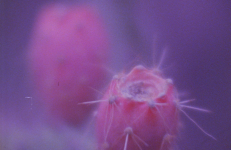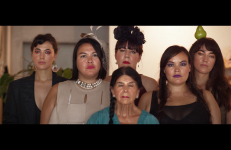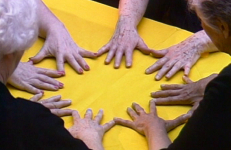Starting with student-recorded VHS footage of two successive Take Back the Night marches at Princeton University, Birnbaum develops a saga of political awareness through personalized experiences. This localized student activity then progresses to, and is contrasted with, the 1988 National Student Convention at Rutgers University. Through this dynamic portrait, Birnbaum posits a series of compelling questions: How can the voice of the individual make itself seen and heard in our technocratic society? What forms of demonstration support this expression? How is a voice of dissent made possible?
Feminism
Unhinging the narrative conventions and stereotypical elements of the whodunit occult thriller, Chained Reactions is an update of film noir style. Calling on the cliches of gothic romance novels and television soap operas, Chained Reactions presents an increasingly dense collage of symbolic, absurd, and everyday images and gestures, challenging the viewer to find the associative meanings that link them. The soundtrack, composed of whispers, music, and sound effects, sets a suspenseful, unresolved tone.
Judy Chicago (b.1939) is an artist, author, feminist, educator, and intellectual whose career now spans four decades. In 1974, Chicago turned her attention to the subject of women’s history to create her best known work, The Dinner Party, which was executed between 1974 and 1979 with the participation of hundreds of volunteers. This monumental multimedia project, a symbolic history of women in western civilization, has been seen by more than one million viewers during its 16 exhibitions held at venues spanning six countries.
Judy Chicago (b.1939) creates large-scale, collaborative artwork has brought greater prominence to feminist themes and craft arts such as needlework and ceramics. Her most famous work, The Dinner Party (1979), was an enormous collaboration with hundreds of volunteers including ceramicists, china painters and needleworkers. The monumental finished piece has place settings for 39 mythical and historical famous women, writing them back into the heroic history usually reserved for men. Earlier in her career, Chicago was part of the Finish Fetish movement within Minimalism.
In Chicken on Foot, Sobell bounces a chicken carcass as one would a child, periodically crushing eggs (fetal chickens) on her knee. A statement of the displacement of sexual desire on food and women’s bodies, and an expression of female ambivalence about motherhood.
Shot primarily in Fisher-Price pixelvision, for the “murky look of memory," Coal Miner’s Granddaughter is a profoundly moving family portrait focusing on the youngest daughter Jane, as she leaves her Pennsylvania home and finds sexual independence in San Francisco. This semi-autobiographical narrative is remarkable for Dougherty’s unconventional approach: working with non-professional, plain-looking actors and improvised dialogue to recreate the life of the “average” family, and women who are “Plain Janes with big desires.”
Color Schemes was exhibited in its installation form (with a self-service washing machine) at the Whitney Museum in 1990. Using the washing machine as a metaphor for the great American “melting pot” of ethnicity, the video presents individuals from a variety of ethnic backgrounds “representing” their ethnicity — in one sense by being on camera, and also by acting out or speaking about ethnic divisions. Cheang plays with this “overdetermiNation” of ethnicity, creating a multi-layered discourse on racism and assimilation that condemns the former and refuses to condone the latter.
“The second in a planned trilogy of films about desire and domesticity that began with Strangely Ordinary This Devotion (2017), Come Coyote examines issues around queer reproduction, intimacy, and motherhood. Collaborators and partners Dani and Sheilah ReStack capture in fleeting, diaristic images the tender and terrifying feelings they have around ushering new life into the world, conveyed with both humor and a powerful immediacy."
— Projections at NYFF, 2019 catalogue
“The second in a planned trilogy of films about desire and domesticity that began with Strangely Ordinary This Devotion (2017), Come Coyote examines issues around queer reproduction, intimacy, and motherhood. Collaborators and partners Dani and Sheilah ReStack capture in fleeting, diaristic images the tender and terrifying feelings they have around ushering new life into the world, conveyed with both humor and a powerful immediacy."
— Projections at NYFF, 2019 catalogue
This humorous video begins with two women—one white, the other Asian—attempting to fit into a Japanese bathtub. The awkward fitting of bodies into a small space is just one of the allegorical scenarios dramatized in a pressing appeal for lesbian rights. In a game of hanafuda (flower cards), the terms of lesbian domesticity are cleverly played out according to such legalities as joint property, social security, and pensions.
Script/Performance Izumo Marou and Claire Maree, Superdyke Inc. Japan.
Song by Chu.
Community Action Center is a 69-minute sociosexual video by A.K. Burns and A.L. Steiner which incorporates the erotics of a community where the personal is not only political, but sexual. This project was heavily inspired by porn-romance-liberation films, such as works by Fred Halsted, Jack Smith, James Bidgood, Joe Gage and Wakefield Poole, which served as distinct portraits of the urban inhabitants, landscapes and the body politic of a particular time and place.
Community Action Center is a 69-minute sociosexual video by A.K. Burns and A.L. Steiner which incorporates the erotics of a community where the personal is not only political, but sexual. This project was heavily inspired by porn-romance-liberation films, such as works by Fred Halsted, Jack Smith, James Bidgood, Joe Gage and Wakefield Poole, which served as distinct portraits of the urban inhabitants, landscapes and the body politic of a particular time and place.
Illustrating the modern woman’s mantra “I shop therefore I am", Barbara Latham’s Consuming Passions examines the passion for sweets as a replacement for a sense of security and a source of erotic satisfaction.
Coyolxauhqui recasts the mythical dismemberment of the Aztec Moon goddess Coyolxauhqui by her brother Huitzilopochtli, the deity of war, the Sun and human sacrifice. The film is a poem of perception, one that unveils how contemporary Mexican femicide is linked to a patriarchal history with roots in deeper cultural constructs.
Six powerful native women gather up to celebrate a new beginning and the end of the world as we know it.
Featuring: Alanis Obomsawin, Nadia Myre, Swaneige Bertrand, Nahka Bertrand, Emilie Monnet, Caroline Monnet
This title is also available on the compilation What Was Always Yours and Never Lost.
“The idea was to address the cultural invisibility of older women through art and through action,” the voice-over explains as this video begins. This short works offers an introduction to the Whisper Minnesota Project, which organized The Crystal Quilt performance, an event that brought together hundreds of women over 60 on a Mother’s Day in Minneapolis. As the video explains, “The Crystal Quilt is a case study in reframing notions of older women’s beauty, power, and relevance. Through it we catch glimpses of life patterns and values lost to our generation.”
In this video, the unseen narrator describes her inability to communicate to the camera what she wants to say and to whom she wants to say it. The curtain is the central metaphor for the piece, representing how Latham hides behind the video medium, as well as how the medium presents an obstacle to the artist, functioning as a cumbersome intermediary to expression.
This title is also available on Barbara Latham Videoworks: Volume 1.
In conversation with Carol Vontobel (behind the camera) and Nancy Cain, Curtis (Mary Curtis) Ratcliff describes getting her first legal abortion, soon after the state of New York legalized the procedure in 1970. Curtis supplies details of the cost of abortions at the Women’s Medical Center in New York City versus clinics such as Planned Parenthood, as well as a play-by-play account of her experience at the Center, describing the efforts of a counselor, the doctor’s demeanor, and demographics of the women using the Center’s services.
Using “found” imagery shot in a SoHo playground, the first part of the Damnation of Faust trilogy explores the possible relations between childhood play and a woman looking on from outside. Without dialogue, the gestures of the characters become their primary mode of communication. Visual motifs of pillars and fans, achieved through video wipes, plunge the viewer into the image while building parallels of movement and feeling.
The second part of the Damnation of Faust Trilogy centers on the development of Marguerite, the female character in the Faust legend. Masterfully composing fragmentary "memory" images in elegant 19th Century Japanese compositions, Birnbaum traces the process of deception and abandonment through the heroine’s mournful description of her state of mind. Passing images are suffused with light, obscured in a blinding brightness, to suggest forgetting.
“Fouteen-year-old bone collector Maxine Rose is looking for validation from her heroes, amongst them the primatologist Jane Goodall, Archbishop Desmond Tutu and the New Zealand teen pop star Lorde. Offering them a gift of language, Maxine Rose stands for the desire to be visible and understood, not unlike the desire of an artist. We are particularly impressed by the multilayered story telling structure, the freshness of the characterization, and the honest exploration of an artists` vulnerability."
“Fouteen-year-old bone collector Maxine Rose is looking for validation from her heroes, amongst them the primatologist Jane Goodall, Archbishop Desmond Tutu and the New Zealand teen pop star Lorde. Offering them a gift of language, Maxine Rose stands for the desire to be visible and understood, not unlike the desire of an artist. We are particularly impressed by the multilayered story telling structure, the freshness of the characterization, and the honest exploration of an artists` vulnerability."
Defiantly humorous in its tone, Delirium reflects Faber’s mother’s personal experience with what has been classified as “female hysteria.” While never reducing her mother’s condition to a single explanation, Delirium firmly and convincingly links her illness to the historically embattled position women hold in a patriarchal culture. The video layers haunting imagery and humorous iconoclasm, referencing everything from television episodes of I Love Lucy to Charcot’s 19th Century photos of female hysterics.
Like a generation of viewers, I was profoundly affected by Deliverance. But I have always been troubled by the hegemonic structures of gender proposed by Boorman and Dickey. Hence, my version is played by women: myself, Peggy Ahwesh, Jackie Goss, Su Friedrich, and Meredith Root, all experimental filmmakers who work as academics. While faithful to our respective male characters, we also play ourselves.
Executive produced by Sara Diamond at the Banff Art Centre, co-produced by Michelle Baughn and Suzanne Lacy, directed by Tom Weinberg and Dick Carter, and edited by Holen Kahn.

























